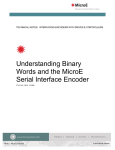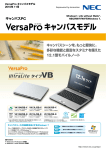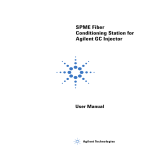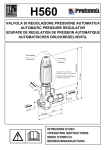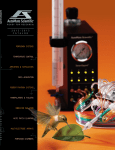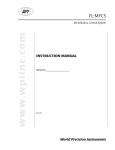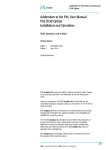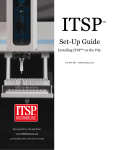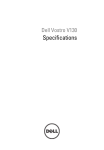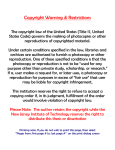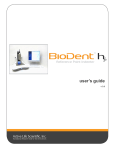Download Addendum to PAL System User Manual PAL MALDI Option
Transcript
Addendum to PAL System User Manual PAL MALDI Option Addendum to PAL System User Manual PAL MALDI Option Printing History Edition 1 September 2005 CTC Analytics AG reserves the right to make improvements and/or changes to the product described at any time without notice. CTC Analytics AG makes no warranty of any kind with regards to this product, including but not limited to, the implied warranties or merchantability and suitability for a particular purpose. In no case shall CTC Analytics AG be liable for any coincidence ore consequential damages in connection with or arising from the use of this document. © 2005 CTC Analytics AG. All rights reserved. Neither this publication nor any part of this publication may be copied, photocopied, reproduced, translated or reduced to any electronic medium or machine readable form without the prior written permission of CTC Analytics AG, except as allowed under the copyright laws. CTC Analytics AG acknowledges all trade names and trademarks used as the property of their respective owners. 1 Addendum to PAL System User Manual PAL MALDI Option Safety Information General Considerations Changes or modifications to this unit not expressly approved by the party responsible for compliance could void the user’s authority to operate the equipment. The user shall be made aware that if the equipment is used in a manner not specified by the manufacturer, the protection provided by the equipment my be impaired. When you use the PAL System, follow the generally accepted procedures for quality control and methods development. When you use the PAL System in the field of chromatographic analysis and you observe a change in the retention of a particular compound, in the resolution between two compounds, or in peak shape, immediately determine the reason for the changes. Until you determine the cause of a change, do not rely on the separation results. Other Hazards To avoid injury during PAL System operation, keep your hands away from the syringe. Do not operate the PAL System without the safety shield. The safety shield must be installed for safe operation. To avoid injury, observe safe laboratory practice when you handle solvents, change tubing, or operate the PAL System. Know the physical and chemical properties of the solvents you use. See the Material Safety Sheets from the manufacturer for the solvents in use. Use caution when working with any polymer tubing under pressure: • Always wear eye protection when near pressurized polymer tubing. • Do not use polymer tubing that has been severely stressed or kinked. • Do not use polymer tubing, in particular not PEEK or Tefzel tubing, with Tetrahydrofuran (THF), Dimethylsulfoxid (DMSO), chlorinated organic solvents, concentrated mineral acids, such as Nitric, Phosphoric or Sulfuric acids, or any related compounds to above listings. 2 Addendum to PAL System User Manual PAL MALDI Option PAL MALDI Option Operating Manual How to use this manual 5 1. 1.1 1.2 1.3 General System Overview Specifications Hardware requirements Software requirements 6 7 7 7 2. 2.1 2.2 2.3 2.4 2.5 2.6 Installation Unpacking the Components Installing the PAL MALDI Tool Parkstation Installing the Magnetic Gripper Basic Installation of the MALDI Tool Installation Variations of the MALDI Tool Installation of MALDI Plate Adapters 8 8 9 10 11 13 13 3. 3.1 3.2 3.3 PAL MALDI Option Object Position Adjusting Object Reference Positions Adjusting Position of MALDI Tool Parkstation Setting MALDI Tool Offset 14 14 14 16 4. PAL MALDI Option Utility Functions 17 5. Cycle Composer Control 19 Appendices A Definition of Terms B Naming Conventions C PAL MALDI Option Spare Parts 21 21 22 23 3 Addendum to PAL System User Manual PAL MALDI Option List of Figures Figure 1 Figure 2 Figure 3 Figure 4 Figure 5 Figure 6 Figure 7 Figure 8 Figure 9 Figure 10 Figure 11 Figure 12 Figure 13 Figure 14 Figure 15 PAL MALDI Option General System Overview PAL MALDI Option Parts Attaching the Tool Parkstation to the X-axis Attachment of Mounting Claws Location of the Tool Parkstation Attaching the Magnetic Gripper to the PAL Z-axis Installing the Tool Parkstation Installing the MALDI Tool Installation variations of the MALDI Tool Installation of MALDI Plate Adapters Object Position of MALDI Tool Parkstation MALDI Tool Setup Object Screen Utility Menu Screen Object Tools Object Position of MALDI Tool Offset Cycle Composer example macros 6 8 9 9 10 11 12 12 13 13 14 15 17 18 20 4 Addendum to PAL System User Manual PAL MALDI Option How to Use this Manual The manual is divided into two sections PAL-MALDI Option Operating Instructions Appendices The "PAL MALDI Option Operating instructions" are intended for frequent PAL users or new users that are experienced in using automated systems to perform existing analytical methods. note ! The HTS PAL or HTC PAL must be installed and set up properly before the PAL MALDI Spotter Operating Instructions can be used. The Appendices provide information about the PAL MALDI Options and Spare Parts. 5 Addendum to PAL System User Manual PAL MALDI Option PAL MALDI Option Operating Instructions 1. General System Overview Figure 1. PAL MALDI Option General System Overview The PAL MALDI Option micro collector/spotter is an add-on PAL module for micro scale fraction collection or MALDI Spotting together with any Capillary LC or Nanoflow LC system. The collection of very low volume fractions requires low delay volumes and high position accuracy of the capillary tip. The principles of operation for the PAL MALDI Option micro collector/spotter will be illustrated in this manual along with descriptions on how to set up the hardware and change the configuration. This enables the user to run the instrument with optimal performance. 6 Addendum to PAL System User Manual PAL MALDI Option 1.1. Specifications Part Number: PAL MALDIOpt Flow Rate: max. 300µl/min Min. time slice: 3 seconds per fraction or target (20 fractions or spots/min.) Delay volume: approx. 3µl with 1 meter PEEK Tubing ID 65µm; approx. 10nl if column is installed inside MALDI Tool Fraction vessel capacity: HTS PAL: max. 23 Shallow plates / 11 Deepwell plates / 594 2ml vials HTC PAL: max. 11 Shallow plates / 5 Deepwell plates / 270 2ml vials MALDI Target capacity: (96 or 384 well compatible) up to 24, depending on vendor and PAL instrument type Supported Targets: Targets of Bruker Daltonics, ABI/Sciex, Waters, Agilent Cooling option: Optional thermostatted Fraction and Target storage Transfer tubing kit: 4°C – 40°C 2m 1 pc 1 pc 10 pcs. 3 pcs. PEEK tubing ID 65µm / OD 1/16” PEEK Nano Y-connector for 360µm capillary tubing PEEK Union 10-32 to 10-32, 0.005” thru-hole FEP Sleeves for 340µm - 380µm capillary tubing Coated Spotting Tips Software Control: By Cycle Composer Software Version 1.5.3 or higher or PAL ICC PAL Firmware: Version 3.0 or higher Wetted parts: PEEK, Fused Silica Net Weight: 550 g 1.2 Hardware requirements The PAL MALDI Option can be used with any HTS PAL or HTC PAL equipped with a side slitted Injection unit. PAL LC can not be used with PAL MALDI Option. 1.3 Software requirements The PAL MALDI Option requires PAL Firmware 3.0 or higher. It can be controlled by Cycle Composer software 1.5.3 or higher or any data system that controls the PAL using PAL ICC (e.g. Analyst, ChemStation, Empower, EZChrom, MassLynx, Xcalibur). 7 Addendum to PAL System User Manual PAL MALDI Option 2 Installation 2.1 Unpacking the Components The MALDI Option is shipped in one single box. Check for the completeness for following items (some parts are preassembled): 1. 2. 3. 4. 5. 6. 7. 8. 9. 10. Figure. 2. 1pc 1pc 1pc 1.5m 1pc 1pc 10pcs 3pcs 1pc 10pcs PAL MALDI Tool PAL MALDI Tool Parkstation Magnetic Gripper incl. 2 pcs. mounting screws PEEK tubing ID 65µm / OD 1/16” PEEK Nano Y-connector for 360µm capillary tubing PEEK Union 10-32 to 10-32, thru-hole 0.13mm FEP Sleeves for 340µm - 380µm capillary tubing Coated Spotting Tips Parkstation Waste Tube PEEK nuts 10-32 1/16" PAL MALDI Option parts 8 Addendum to PAL System User Manual PAL MALDI Option 2.2 Installing the PAL MALDI Tool Parkstation Before beginning the installing process, determine approximately where the PAL MALDI Tool Parkstation should be placed. It must be positioned near the left end of the PAL X-axis. 1 Install the Tool Parkstation with the mounting clamp teeth fitting into the grooves on the bottom of the X-axis. The Parkstation must be mounted near the left end of the PAL X-axis. Be sure that the clamp fits completely into the grooves. Tighten the Torx screw until the mounting clamp is firmly in place. Figure 3. Attaching the Tool Parkstation to the PAL X-axis 2 Double check if the Tool Parkstation mounting clamp is correctly attached to the PAL X-axis (see Figure 4) Figure 4. Attaching PAL objects to the PAL X-axis Connect one end of the delivered Waste tube to the Tool Parkstation waste port. Insert the other end into an appropriate waste container. note ! The distance between the right edge of the Tool Parkstation and the left edge of a PAL Stack, PAL Stack Cooler or PAL Trayholder must be > 85mm (see Figure 5) 9 Addendum to PAL System User Manual PAL MALDI Option Figure 5. Location of the Tool Parkstation 2.3 Installing the Magnetic Gripper 1 Turn OFF the PAL Power Supply. 2 Slide down manually the black syringe carrier inside the Z Crossrail until the two threaded holes located on its left side are visible. 3 Locate the two supplied Torx screws and attach the Magnetic Gripper securely to the black syringe carrier. (see Figure 6). 10 Addendum to PAL System User Manual PAL MALDI Option Figure 6. Attaching the Magnetic Gripper to the PAL Z-axis 2.4 Basic Installation of the MALDI Tool 1 The MALDI Tool is already preassembled using the PEEK tubing ID 0.0025" / OD 1/16”, the PEEK Union 10-32 to 10-32, the PEEK nuts 10-32 1/16" and one coated spotting tip according Fig. 8 (view parts on Fig. 2, page 13) 2 Put the MALDI Tool into the Tool Parkstation. 3 Guide the end of the PEEK tubing through the the red fitting mounted at the rear side of the Tool Parkstation. Make sure the tubing length allows the MALDI Tool to reach the whole working area but keep it as short as possible. If the necessary tubing length is properly adjusted, tighten the red fitting on the Tool Parkstation (view Fig. 7 page 17). 4 Connect the PEEK tubing to your HPLC system. Keep the length as short as possible to minimize delay volume. note ! The MALDI Tool is pre-assembled to show its correct installation. It is delivered with 1.5m PEEK tubing ID 0.0025" / OD 1/16”. For other ID's contact your PEEK or Fused Silica tubing supplier. Note that improper MALDI Tool connections can lead to leaks or the formation of dead / delay volume, both may result in poor performance. 11 Addendum to PAL System User Manual PAL MALDI Option Figure 7. Installing the Tool Parkstation Figure 8. Assembling the MALDI Tool 12 Addendum to PAL System User Manual PAL MALDI Option 2.5 Installation Variations of the MALDI Tool The PAL MALDI Option can be configured in various different modes. Depending on the application the plumbing method may be slightly different. Some examples of possible configurations are shown below. Figure 9. Installation variations of the MALDI Tool 1 PEEK tubing, no matrix addition, HPLC column inside HPLC system 2 Fused silica tubing, no matrix addition, HPLC column inside HPLC system 3 Fused silica tubing, online matrix addition via Nano Y-connector, HPLC column inside MALDI Tool 2.6 Installation of MALDI Plate Adapters Insert the appropriate MALDI plate carefully to its corresponding MALDI plate adapter. Depending on the plate type some adapters are equipped with location pins. For accurate positioning all Target adapters are spring loaded on their right side. Insert the adapter into a PAL Stack Drawer or a PAL MT Trayholder as shown in Fig. 10, page 18. Double check if the MALDI plates and its adapters are firmly in place. If regular 96/384 well microplates for micro fraction collection are used the plates are inserted directly without adapter into a PAL Stack Drawer or a PAL MT Trayholder. Figure 10. Installation of MALDI Plate Adapters 13 Addendum to PAL System User Manual PAL MALDI Option 3. PAL MALDI Option Object Positions 3.1 Adjusting Object Reference Positions note ! Remove the Syringe Adapter from the Injection Unit before performing the following steps. It is assumed that the necessary firmware version and the PAL MALDI Option object list is installed on the PAL instrument. All existing PAL Objects (e.g. PAL Sample Stacks, Trayholders etc.) must already be properly defined according to the corresponding HTS or HTC PAL Operation Manual. The objective is to adjust the reference positions for the PAL MALDI Option. Make sure the MALDI Tool Parkstation including the MALDI Tool and tubing, the Magnetic Gripper, the MALDI Plate adapter including the appropriate target plate or microplate are properly mounted to the PAL. 3.2 Adjusting Position of MALDI Tool Parkstation The reference position of the MALDI Tool Parkstation is shown in Fig. 11. The bottom side of the Magnetic Gripper should slightly touch the top side of the blue Parkstation tube. Figure 11. Position of MALDI Tool Parkstation 14 Addendum to PAL System User Manual PAL MALDI Option 1 Remove the MALDI Tool from Tool Parkstation 2 When the "Job Queue" menu is displayed, complete the following sequence 3 After selecting MALDISpt the X Y Z positions for the MALDI Tool Parkstation (ParkingPos) will be displayed (see Figure 12). Figure 12. MALDI Tool Setup Object Screen 4 Select the item ParkingPos Y with the cursor bars and press ENTER. The Injection Unit will move to the actual defined Y-axis position. 5 Do not change the value because it is preset to an approximate value. 6 Press the inner knob to enter the ParkingPos Y value. 7 Repeat steps 4-6 first for ParkingPos Z and last for ParkingPos X. The X position is preset to 0 and has to be adjusted. 8 Fine tune the X, Y and Z values until the black Magnetic Gripper fits exactly to its position shown in Fig. 11. 9 Verify the defined X Y Z Positions by pressing F1 "Check Pos". note ! Pressing the F3 button "Movto Zero" will move the injection unit to the ZeroPosition. 15 Addendum to PAL System User Manual PAL MALDI Option 3.3 Setting MALDI Tool Offset The offset between injection syringe needle and coated spotter tip has to be adjusted after installation of the MALDI Option to ensure the required precision for MALDI spotting. After the hardware and software has been set up properly follow the procedure described in Chapter 4, PAL MALDI Option Utility Function to adjust the tool offset. Reference position of the MALDI Tool Offset (offset between Injection syringe needle and coated spotter tip) is described in Fig. 13. The spotter tip should just be above the center of position 1 of the MALDI Target or the center of the first microplate well. note ! The procedure of adjusting the Tool Offset has to be repeated every time a change is made at the MALDI Tool assembly, especially if the Spotting Tip is exchanged. 16 Addendum to PAL System User Manual PAL MALDI Option 4 PAL MALDI Option Utility Function The PAL MALDI Option Utility function, selectable from the Menu screen, provides quick access to MALDI positioning parameters that may need to be fine adjusted. note ! The MALDI Tool adjustment applies for all Trays, there is no individual adjustment for each Tray. To have a consistent precision from plate to plate it is important that the Trays have been fine adjusted using the Tray utility function. See the PAL manual for a description of the Tray utility function. 1 Insert the MALDI Tool into the Tool Parkstation 2 Insert the MALDI Target Adapter incl. Target or the microplate into the Sample Stack Drawer or Trayholder, close all Stack Drawers. 3 Switch on the instrument. 4 Starting with function key F1, complete the following sequence 5 For TeachPoint select the Tray that holds the MALDI Target or microplate inserted in step 2. This Tray will be used to adjust the MALDI Tool position (see Figure 15, page 23). Figure 13. Utility Menu Screen Object Tools 5 Scroll to ToolOffset Z and set the value to -20.0 mm. note ! This step is important if the Tool Tip has been changed. Otherwise if the new tip is longer than before it will hit the plate when moving to the Tray in the next step. 6 Press F1 “Check Offs”. The Injection Unit will open the Stack drawer (if present), pick-up the MALDI Tool and move to the Tray selected in TeachPoint, sample position 1. 17 Addendum to PAL System User Manual PAL MALDI Option Figure 14. Object Position of MALDI Tool Offset 7 Select ToolOffset Z and move down until the Tool Tip is close to the MALDI Target surface. Because the polished MALDI Target plates act as a mirror the correct position is reached when the tip and its mirror image are close together. In case of a microplate adjust the Z value to the top surface of the plate. 8 Adjust ToolOffset X and Y so that the Tool Tip is perfectly centered to the sample 1 position. 9 Press F1 “Rest Tool” The MALDI Tool will be restored to the Parkstation and eventually the stack drawer will be closed. note ! The adjustment of the MALDI Tool Offset must be done carefully. Small variations result in improper drop deposition. 18 Addendum to PAL System User Manual PAL MALDI Option 5 Cycle Composer Control note ! To operate the PAL MALDI Option via Cycle Composer software, it is assumed that the user is familiar with the PAL Cycle Composer control software. The PAL MALDI Option can only be used together with the PAL control software Cycle Composer. Make sure the hard- and software requirements meet with your installation, before operating the MALDI Option. (see page 12, 1.2 Hardware requirements / 1.3 Software requirements) Every PAL MALDI Option is shipped with a CD-ROM containing 5 different MALDI application examples (see Fig. 16, page 26). These examples may be used to get familiar with the MALDI Option and are a good starting point to develop your own applications. Copy these examples to your Cycle Composer method folder. 19 Addendum to PAL System User Manual PAL MALDI Option Macro Name Macro Description Macro Variables Collect to MALDI Plate Start spotting to MALDI plate after "Collection Start Delay". The MALDI plate is selected with "Tray" and starting position with "Vial" from the sample list. Start spotting to MALDI plate after "Collection Start Delay". The MALDI plate is selected with "Tray" and starting position with "Vial" from the sample list. Before collection starts the probe is moved to "Collection Waste Position" so the first spot will be accurate. Inject sample selected in "Tray" and "Vial" in the sample list. Start spotting to MALDI plate after "Collection Start Delay" measured from injection. (Cleaning of the syringe and injector must be terminated before). The MALDI plate is selected with "Tray2" in the sample list. Collection Start Delay Collection Time Number of Collections Collect to MALDI plate with Waste Start Inject and Collect to MALDI Plate Figure 15. Inject and Collect to MALDI Plate with Waste Start Inject sample selected in "Tray" and "Vial" in the sample list. Start spotting to MALDI plate after "Collection Start Delay" measured from injection. (Cleaning of the syringe and injector must be terminated before). The MALDI plate is selected with "Tray2" in the sample list. Before collection starts, the probe is moved to "Collection Waste Position" so the first spot will be accurate. Micro Fraction Collection Start collecting to plate after "Collection Start Delay". The plate is selected with "Tray" and starting position with "Vial" from the sample list. Well Offset is half the diameter of the collection well. Well penetration is taken from the plate. Collection Start Delay Collection Time Number of Collections Collection Waste Position Air Volume Pre Clean with Solvent 1 Pre Clean with Solvent 2 Pre Clean with Sample Filling Speed Filling Strokes Inject to Injection Speed Pre Inject Delay Post Inject Delay Post Clean with Solvent 1 Post Clean with Solvent 2 Valve Clean with Solvent Valve Clean with Solvent Collection Start Position Collection Start Delay Collection Time Number of Collections Air Volume Pre Clean with Solvent 1 Pre Clean with Solvent 2 Pre Clean with Sample Filling Speed Filling Strokes Inject to Injection Speed Pre Inject Delay Post Inject Delay Post Clean with Solvent 1 Post Clean with Solvent 2 Valve Clean with Solvent 1 Valve Clean with Solvent 2 Collection Start Position Collection Start Delay Collection Time Number of Collections Collection Waste Position Collection Start Delay Collection Time Number of Collections Well Offset Cycle Composer MALDI Example Macros 20 Addendum to PAL System User Manual PAL MALDI Option Appendices A. Definition of Terms Job Queue A Job Queue is a list of sample processing Jobs. Jobs are executed in the order displayed on the JOB QUEUE menu screens. New Jobs may be added to the queue while samples are being processed. Job A Job contains the information needed by the PAL to process multiple samples by the same processing steps. The elements of a Job are a Method and a Tray that defines the location of the samples to be processed. For identification, Jobs are automatically numbered from 01 to 99 and then restarting with 01 when they are added to the Job Queue. Cycle A Cycle consists of the specific operations necessary to process one sample. The Cycle operations are repeated for each sample within a Job. Cycles are designed for specific applications. The Standard HTS PAL Cycle is named LC-Inj. Method A Method defines how the samples are processed. The elements of a Method are a Cycle, a Syringe and a Parameter List. Methods have names with up to 8 characters and can be edited, copied, and deleted. Method Parameters Method Parameters are associated with the Cycle operations. User-assigned Parameter values define how a processing operation is performed. A zero Parameter value will disable a Cycle operation. Cycle parameters are application-specific. Object Objects are data structures describing the properties of physical modules. Certain modules (e.g. a Stack) require several objects. Trayholder A Trayholder can hold one or more trays. Each Trayholder has a reference position (X, Y, Z coordinates) that defines its location. Stack A Stack is a particular type of Trayholder, that is designed to hold micro-plates. A six-drawer Stack holds 12 standard micro-plates two in each drawer. A three-drawer Stack holds six deep-well micro-plates two in each drawer. Tray A Tray that holds multiple samples. Trays are defined by designating the Tray Type (see below) and the Trayholder. Tray names are used to identify the sample source within a PAL Job. Tray Type A Tray Type defines the pattern and sampling sequence of sample locations within a Tray. Standard Tray Types include shallow and deep-well 96-position Microplates and Trays that hold 1, 2, 10, and 20ml vials or MALDI Targets. 21 Addendum to PAL System User Manual PAL MALDI Option B. Naming Conventions This section recommends standard naming conventions for MALDI Targets and Microplates. Following these conventions will allow PAL MALDI Setup's to be pre-configured for certain applications, will simplify software backups and application development, and will improve technical support and training. note ! Tray Type Vendor P/N Tray Description MT96 various Standard 96-position shallow microplates DW96 various Deep well 96-position microplates MT384 various High density 384-position shallow microplates VT54 CTC 54 position 2ml vial tray BRK16x24 Bruker 384 spots MTP Anchor Chip, steel ABI10x10 ABI/Sciex P/N V700664 100 spots SS, numbered, with etched circles MM 8x12 Waters P/N M880675CD1 96 spots MM 16x24 Waters P/N M880356BD1 384 spots MM 8x12 Waters P/N 186002322 96 spots, MassPREP DIOS-target AGI 8x12 Agilent P/N G1972-60025 96 spots The list above reflects the status of August 2005. Check the delivered CD-ROM or with your CTC Analytics representative for new MALDI Target Types 22 Addendum to PAL System User Manual PAL MALDI Option C. PAL MALDI Option Spare Parts Part no Description MZ 24-01 Magnetic Gripper incl. screws MM 010-01 PAL MALDI Tool Parkstation P-773 PEEK Nano Y-connector P-779-01 PEEK Union thru-hole 0.13mm PAL TubeWaste Parkstation Waste Tube PAL MaldiTip/3 3pcs Spotting Tips with special coating 1560 1.5m PEEK Tubing ID 65um / OD 1/16" F-331NX 10pcs PEEK Nuts 10-32 1/16" F-242X 10pcs FEP Sleeves for 340um – 380um capillary tubing 23
























